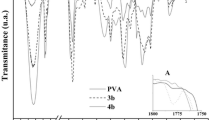Summary
Two different routes for the preparation of hydrophobically modified poly(vinyl alcohol), PVA are reported. The first method involves the formation of the polymeric alcoholate. An alkylhalide and propanesultone are coupled with the polymer in two subsequent steps of the Williamson ether synthesis. The product is a hydrophobically modified polymer with anionic functionality. The other method proceeds via a 1,4 addition of acrylamide and the Hoffman degradation of the amide to an amine. In the next step, the amine is alkylated with an alkylhalide. The polymers are characterised by quantitative 1HNMR spectroscopy and titration.
Similar content being viewed by others
Author information
Authors and Affiliations
Additional information
Received: 14 January 1999/Revised version: 19 April 1999/Accepted: 19 April 1999
Rights and permissions
About this article
Cite this article
Marstokk, O., Roots, J. Synthesis and characterization of hydrophobically modified poly(vinyl alcohol). Polymer Bulletin 42, 527–533 (1999). https://doi.org/10.1007/s002890050498
Issue Date:
DOI: https://doi.org/10.1007/s002890050498




